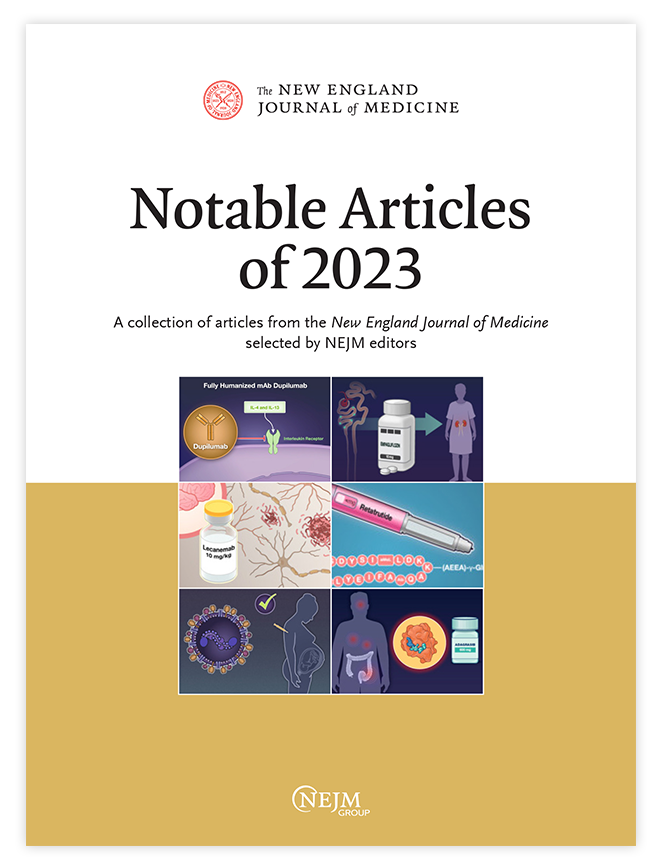Early Tirofiban Infusion after Intravenous Thrombolysis for Stroke.
IF 96.2
1区 医学
Q1 MEDICINE, GENERAL & INTERNAL
引用次数: 0
Abstract
BACKGROUND Intravenous thrombolysis remains a standard treatment for acute ischemic stroke within 4.5 hours after onset. Vascular reocclusion may occur after intravenous thrombolysis and may be preventable with an antiplatelet agent within the first 24 hours after thrombolysis. Tirofiban, a platelet glycoprotein IIb-IIIa receptor antagonist, has reduced macrovascular reocclusion in experimental models. METHODS In this phase 3, multicenter, double-blind, randomized, placebo-controlled trial conducted at 38 centers in China, we assigned patients with acute ischemic noncardioembolic stroke who presented within 4.5 hours after stroke onset and who were not eligible for thrombectomy to receive a 24-hour intravenous infusion of tirofiban or placebo within 60 minutes after intravenous thrombolysis. The primary efficacy outcome was an excellent functional outcome, defined as a score of 0 to 1 on the modified Rankin scale, at 90 days. The safety outcomes were symptomatic intracranial hemorrhage within 36 hours and death at 90 days. RESULTS A total of 414 patients were assigned to receive tirofiban and 418 to receive placebo. Thrombolytic agents included alteplase (in 75% of the patients) and tenecteplase (in 25%). At 90 days, a score of 0 to 1 on the modified Rankin scale was reported in a higher percentage of patients in the tirofiban group than in the placebo group (65.9% vs. 54.9%; risk ratio, 1.20; 95% confidence interval, 1.07 to 1.34; P = 0.001). Symptomatic intracranial hemorrhage occurred in 1.7% of the patients in the tirofiban group and none in the placebo group. Mortality at 90 days was 4.1% in the tirofiban group and 3.8% in the placebo group. CONCLUSIONS In patients with acute ischemic noncardioembolic stroke who underwent thrombolysis within 4.5 hours after onset, early tirofiban increased the likelihood of an excellent functional outcome. The incidence of intracranial hemorrhage was low but higher with tirofiban than placebo. (Funded by the Fundamental Research Funds for Central Universities; ASSET-IT ClinicalTrials.gov number, NCT06134622.).脑卒中静脉溶栓后早期输注替罗非班。
背景静脉溶栓仍然是急性缺血性卒中发病后4.5小时内的标准治疗方法。静脉溶栓后可能发生血管再闭塞,并且可以在溶栓后24小时内用抗血小板药物预防。替罗非班是一种血小板糖蛋白IIb-IIIa受体拮抗剂,在实验模型中可以减少大血管再闭塞。方法:在中国38个中心进行的这项3期、多中心、双盲、随机、安慰剂对照试验中,我们将卒中发生后4.5小时内出现的急性缺血性非心源性卒中患者分配给静脉溶栓后60分钟内接受24小时静脉输注替罗非班或安慰剂的患者。在治疗90天时,主要疗效结局是一个优秀的功能结局,定义为在改良Rankin量表上的0到1分。安全性结果为36小时内出现症状性颅内出血,90天内死亡。结果共414例患者接受替罗非班治疗,418例患者接受安慰剂治疗。溶栓药物包括阿替普酶(75%的患者)和替奈普酶(25%)。在第90天,替罗非班组患者在改良Rankin量表上得分为0到1分的比例高于安慰剂组(65.9% vs. 54.9%;风险比1.20;95%置信区间为1.07 ~ 1.34;p = 0.001)。替罗非班组有1.7%的患者出现症状性颅内出血,而安慰剂组没有。替罗非班组90天死亡率为4.1%,安慰剂组为3.8%。结论:急性缺血性非心源性卒中患者在发病后4.5小时内接受溶栓治疗,早期使用替罗非班可增加获得良好功能结果的可能性。替罗非班组颅内出血发生率较低,但高于安慰剂组。(中央高校基本科研业务费专项资金资助;ASSET-IT ClinicalTrials.gov编号:NCT06134622)。
本文章由计算机程序翻译,如有差异,请以英文原文为准。
求助全文
约1分钟内获得全文
求助全文
来源期刊

New England Journal of Medicine
医学-医学:内科
CiteScore
145.40
自引率
0.60%
发文量
1839
审稿时长
1 months
期刊介绍:
The New England Journal of Medicine (NEJM) stands as the foremost medical journal and website worldwide. With an impressive history spanning over two centuries, NEJM boasts a consistent publication of superb, peer-reviewed research and engaging clinical content. Our primary objective revolves around delivering high-caliber information and findings at the juncture of biomedical science and clinical practice. We strive to present this knowledge in formats that are not only comprehensible but also hold practical value, effectively influencing healthcare practices and ultimately enhancing patient outcomes.
 求助内容:
求助内容: 应助结果提醒方式:
应助结果提醒方式:


